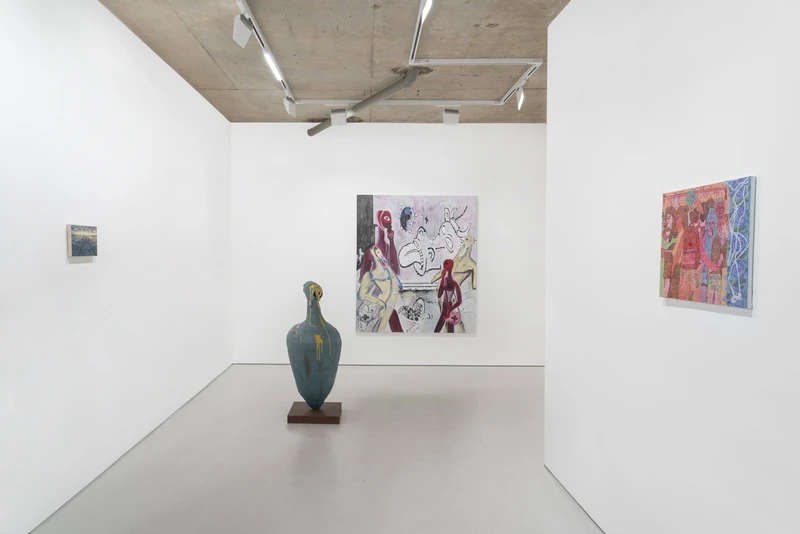The 7th Wall
19 Jan-24 Feb 2024
PV 18 Jan 2024, 6-8pm


The 7th Wall
SCENE I - A gallery in Fitzrovia, London.
The curtains are drawn, the stage is set. The actors have already made their exit. Left behind are their artworks. In them we see, sketched out, objects and architecture, forming an outline of a familiar world. The objects in this world, however, are seemingly out of place, their meanings obscured, reproduced and reappropriated. Their makers have composed the objects in their work into a state where they are rescripted and imbued with their own agency, becoming actors in their own right. No longer obfuscated by a sense of mundanity, they have shed their constructed meaning and have become sites to tell, carry and enact new stories.
SCENE TWO (by Miko Veldkamp)
Early morning sun. Those slow winter mornings where the light peeps through the London smog. The spectator looks at window frames hung on the walls, a surprising view into seemingly tropical dwellings, lush brushes looming in the background. We’ve suddenly stepped out of the city haze. There are the characteristic plastic chairs and fan, tell-tale signs of a Caribbean residence. Yet in the gleaming sun, we hear the tunes of a piano. Listening to the Western instrument’s voice drowning out the sounds of crickets, we see two figures reach out to each other, fusing, refusing to be in one place or time.
SCENE THREE (by Phoebe Collings-James)
We find ourselves back in the gallery, slightly disoriented. A sense of dissent filling the air. We begin to suspect that we are no longer in our familiar world. Enter The Infidel. Looking back to a rich history of West-African pottery, The Infidel’s clay body has risen from the ashes of imperial lands set afire. Erected with a discernible belly and throat, they are a remarkable story teller. A carrier of unbelief and opposition, the clay figure continues its ancestors' long tradition of acting as an alternative channel for communication and knowledge-building.
SCENE FOUR (by Nicholas Grafia)
A different place: some time later, some time earlier. We leave behind The Infidel and walk towards a painted cow on a wall. It is reminiscent of an iconic work by David Wojnarowicz, which was once created on a Pier next to the Hudson River in New York. A flurry of distant sirens and low frequency hum of the city weighs in the air. The abandoned building which first opened up its body for industry, and later for an alternative burgeoning art scene, now hosts a group of masked characters carrying medical bags, maybe from a future to come, leaving us in a timeless contemplation on life and death.
SCENE FIVE (by Lulua Alyahya)
Still not sure where we are. Empty architectural spaces stretch before us with no distinct markers in sight, besides a painting of horses and a t.v. mounted on the wall. One man lounges on the floor, another in a swimming pool, idling. And there, a group of tall buildings, idling as well. Like the human figures, they are standing in empty space, like appearances in a dream. They look at us with a steady and mysterious gaze, leaning on each other. No words are spoken, a tear is shed.
SCENE SIX (by CFGNY)
An in-between place. A few crates, a glass plate, and a collection of vases have gathered on this makeshift pedestal before us. We look upon them, this family of brightly colored objects, only to feel slightly deceived by their appearance. If someone would place flowers in these elegant beings, yes, they would hold them. But these vaguely Asian looking structures are barely holding themselves, their skin still carrying the marks of the surfaces of the various blouses, bottles, and vases that all gathered together to mold and birth them. Dissolve.
SCENE SEVEN (by Talia Levitt)
Sound of distant screeching train wheels. A subway car, destination unknown. We’ve tumbled into a bumpy new reality that is moving ahead with full speed. Laboriously created, this scene has been threaded together to try and impersonate the material of its main characters: a backpack and a pair of wired iPhone headphones. In the background, the train car is filled with human figures, all of them seem tired, holding on to each other, leaning on the subway bars. Silhouetted against the humans, the mundane objects stand, with an unspoken understanding they have shifted from a supporting to leading role.
SCENE EIGHT (by Littlewhitehead)
We step out of the train, into the cold night air. On the floor, there, in the corner; a cold weather hat. It lies spread out on the ground, as if flown off someone's head, and left behind. At closer inspection, we see it is holding shattered tempered glass. Something has been broken, a violent act might’ve taken place. We did not see what happened, yet we feel like we have witnessed a horrible act. We hurry along.
SCENE NINE (by Rinella Alfonso)
Still in the dark, a long lasting night. A shirt flies above us, through the air, in a long arc, then stays afloat in the dark of the night. The fabric silently rustles in the wind. Even though it’s the middle of the night, we have no difficulties seeing this creature. We might be dreaming, but it lights up, somehow. The translucent light ripples through the dark, spreading a comforting warmth similar to that of a pleasant memory, or a sweet, sweet dream.
SCENE TEN (by Jennifer J. Lee)
Still warm and fuzzy, we drift onto a beach. No longer bound to any particular reality, we embrace and take in the pixelated sunrise that lies in front of us. The constructed world we were so sure of just a while ago, has painstakingly been dissected, and been rebuilt. We’re no longer sure we are human or object, digital or analogue, awake or asleep. But somehow, in this metaworld, nothing has ever been more clear.